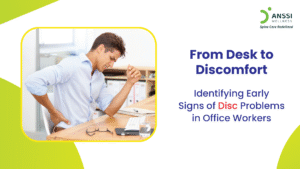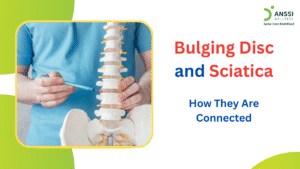A bulging disc is one of the most common spinal issues affecting people across all age groups, especially those with sedentary lifestyles or physically demanding jobs. While the term may sound alarming, many cases of bulging discs can improve with time and appropriate care—often without surgery.
But what exactly is a bulging disc, and how does it differ from other spinal conditions such as a herniated disc? More importantly, can it truly heal on its own?
What is a Bulging Disc?
Your spine is made up of vertebrae separated by intervertebral discs, which act as cushions and shock absorbers. Over time or due to stress, these discs may start to bulge out from their normal boundaries, a condition known as a bulging disc. This bulge can press on nearby nerves, causing discomfort or pain.
This condition is quite different from another common spinal issue known as a herniated disc. A herniated disc occurs when the inner gel-like core of the disc breaks through the outer layer, often leading to more severe pain and nerve compression.
While both conditions can be painful, herniated discs are typically more serious and may require more aggressive treatment. Bulging discs are generally considered the earlier or less severe stage and often respond well to conservative treatments.
Symptoms of a Bulging Disc
Bulging disc symptoms can vary based on the location and severity of the disc’s protrusion.
Common signs include:
- Persistent or intermittent back pain
- Pain radiating to the arms or legs (depending on disc location)
- Muscle weakness or tingling in limbs
- Numbness in affected areas
- Reduced mobility or stiffness
In such situations, people may not even detect any symptoms. The pain often worsens with activity, prolonged sitting, or poor posture and may improve with rest.
What Causes a Bulging Disc?
Several factors can contribute to the development of a bulging disc:
- Age-related degeneration: As we age, spinal discs lose water content, becoming less flexible and more prone to bulging.
- Poor posture: Slouching or hunching over desks can put undue pressure on spinal discs.
- Heavy lifting or trauma: Incorrect lifting techniques or sudden injuries can strain the spine.
- Repetitive motion: Jobs or activities involving repeated bending or twisting increase the risk.
Obesity and lack of exercise: Excess body weight strains the lower back, while a sedentary lifestyle weakens the core muscles that support the spine.
Can a Bulging Disc Heal Naturally?
Yes—many cases of bulging discs can heal on their own with conservative, non-surgical therapies. The body is remarkably resilient and capable of repairing minor disc damage over time, especially when aided by proactive recovery measures.
Here are some effective natural healing tips:
1. Get Adequate Rest (But Not Too Much)
Rest is essential during the initial flare-up of pain. Taking short breaks from strenuous activities allows inflammation to subside and relieves pressure on the disc. However, prolonged bed rest can actually do more harm than good. Aim for short rest periods followed by light activity or gentle movement to prevent stiffness.
2. Use Medication Wisely
Over-the-counter medications like ibuprofen or naproxen can help reduce inflammation and manage pain in the short term. These should be used under a doctor’s supervision and not relied on as a long-term solution. Always avoid self-medicating without proper medical advice, especially if symptoms persist.
3. Engage in Anti-inflammatory Physical Therapy and Gentle Exercises
Once acute pain subsides, physical therapy becomes crucial for recovery. A trained physiotherapist can guide you through customised exercises that:
- Strengthen the core and back muscles
- Improve posture and spinal alignment
- Enhance flexibility and range of motion
Anti-inflammatory exercises such as stretching, walking, yoga, and swimming are particularly helpful. These movements support spinal stability and improve circulation, which accelerates healing.
4. Consider Non-Surgical Spinal Decompression Treatment
One of the most effective, non-invasive treatments for bulging discs is Non-Surgical Spinal Decompression Treatment (NSSDT). This advanced form of treatment gently stretches the spine using a specialised decompression table, creating negative pressure within the discs. This allows the bulging material to retract, relieving nerve pressure and encouraging the flow of nutrients, oxygen, and fluids back into the disc for natural healing.
Clinics like ANSSI Wellness, with locations across India and Dubai, specialise in non-surgical spinal decompression treatment. Their USA protocol-based treatment has helped thousands of patients avoid surgery and recover from chronic back issues in a safe, drug-free manner.
Don’t Ignore the Signs
While a bulging disc can often heal naturally, early intervention is key. Ignoring symptoms or relying solely on painkillers can lead to further degeneration or complications. A combination of rest, physical therapy, healthy lifestyle choices, and advanced treatments like spinal decompression can set you on the path to recovery without the need for surgery.
If you’re experiencing back pain, tingling, or weakness, don’t wait. Consult a spine care expert to determine the best course of action tailored to your condition. With the right approach, a pain-free life is not just possible—it’s within reach.
About ANSSI:
ANSSI Wellness focuses on improving the quality of life for patients suffering from spinal issues, aiming to provide relief where other conventional treatments have failed. Through advanced non-surgical spinal decompression treatment, ANSSI is committed to helping patients avoid surgery and recover in a safe, effective, and compassionate environment.
Connect with ANSSI Wellness on LinkedIn, Instagram, and Facebook for expert guidance.



